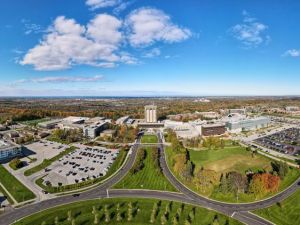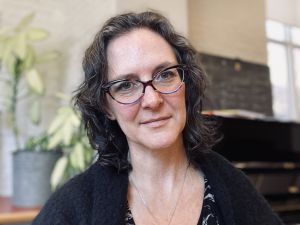The days were long, but coffee was aplenty — and so were the valuable lessons.
The morning pick-me-up was more a necessity than a perk for the team of 20 Earth Sciences students who recently spent 10 days exploring the remote northern Ontario wilderness.
A veteran of the term-ending expedition of the annual 3P99 Field Camp — Solid Earth course, Professor Frank Fueten knew the importance of sending his team out sufficiently fuelled.
Each day, he cooked up a hearty breakfast for the group before they headed out for time in the field examining sedimentary and igneous rocks.
Among the team members was Todd Robinson, a third-year Earth Sciences student who joined the experiential education adventure in hopes of applying the knowledge he learned in class.

Every two days on the way back to their cabins, participating Earth Sciences students would break into groups to buy supplies for the next two days.
“It was a great opportunity to see exactly what it’s like to be a field geologist dealing with all kinds of weather conditions and long days outside, trying to take in as much information as possible,” said the 22-year-old Welland native.
Over the course of the trip, which ran from April 26 to May 5, the group travelled to Sudbury and spent time describing outcrops (large areas of rock sticking out of the ground) between Manitoulin Island and Elliot Lake, focusing on Espanola.
Outside of travel time, seven days were spent in the field, mapping an area of about 17 kilometres along Highway 6.
With much on the go — from mapping rocks and collecting data to producing maps and working on a final written — students often averaged 12-hour days, applying in-class knowledge to field work under the guidance of Fueten and Phil McCausland, Assistant Professor of Earth Sciences.
“This trip took a lot of our class content and put it into an actual work environment,” said third-year Earth Sciences student Ariel Van Patter.
“Every day in the field we got to be hands-on with the rocks,” said the 20-year-old Dorchester, Ont., native. “The outcrops were picked to show us different surface types and structures. The field work allowed us to put together all the information we knew and create a ‘story’ of geologic history.”
Robinson learned a lot from the experience, taking away new knowledge about geology, how to perform field work and work with others.
“You learn to train your eyes to see things that just looked like a broken rock before, but after, you are able to see what may have caused that to happen,” he said. “It’s almost like trying to decipher the past.”
The educational value of the trip was twofold; along with applying in-class knowledge to real-life field examples, students also experienced cabin life and variable weather conditions.
The experience shed light on life in the field — key information for aspiring earth scientists.
Students had to adjust to temperatures ranging from zero to 20°C and experienced little to no running water in four of the seven allotted cabins, but made the most of the off-the-grid challenge nonetheless.
One of Robinson’s favourite moments was the almost daily ‘polar bear dips’ he and several classmates took upon returning to camp.
Ejaz Ahmed, Dean of the Faculty of Mathematics and Science, said the course exemplifies the importance Brock places on providing experiential learning opportunities.
“It is no surprise that the program has enjoyed a more than two-decade-long run. Hands-on work in the field with leading experts provides our students with a competitive edge,” he said. “They are able to take knowledge they learned in a classroom setting and apply it directly in an environment that simulates what they will find in future careers.”
For Robinson, the trip turned out to be everything he expected and more.
“I had a great time learning to look at the outcrops and making my own observations. The experience really brought home the fact that I had chosen the right program for myself at Brock,” he said.
“I wanted a science-based program that involved going outside and getting your hands dirty to acquire the information you need. That’s exactly what I got.”










